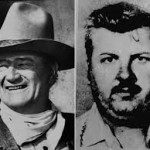
Having enjoyed Tim Burton’s movies through the years, my curiosity went on high alert when I read about his new biopic Big Eyes set to be released this Christmas in a theater near you and me.

Adam Parfrey
Adam Parfrey who runs Feral House Books, a little house of darkness promoting ‘pure information and forbidden subjects,’ has also published a new book called Citizen Keane, telling the story of Walter and Margaret Keane who were 60s pop artists and trail blazers of Kitsch Art, right smack in the middle of the hippie glory days.
Their series of paintings called Big Eyes depicted children with humongous eyes in flashy colors. When I say they, I mean that Margaret was doing the painting and Walter took care of business.
My first encounter with a Big Eyes painting took place in the living room of an old aunt who was in awe of it and practically made it the centerpiece of her house if not to say, her life. Her husband deplored the fact that she paid a fortune for it and had to have it shipped from the US but it was love at first sight, and except for her cat Bimbo, nothing was more enchanting in her eyes than her painting of strange kids with huge mirrors to their soul presiding over their face.

One of the Big Eyes
The Keane’s paintings were a huge hit and in my eyes, they were not very far from velvet paintings of Elvis and Marilyn on the scale of art evolution. I am exaggerating a tad and they were extremely popular and hung in beautiful mansions as well as in trailer park homes. They had touched a nerve and were selling like hotcakes.
Walter Stanley Keane was a former real estate salesman who knew the value of a fad over lasting creative art. So he struck gold with these paintings of semi distressed looking kids that could touch your soul without making you feel depressed. It was sappy and sentimental but not dramatic like real photos of starving children in the third world. They depicted vulnerability but with a soul.
 Big Eyes paintings became so popular that they inspired many to produce countless imitations of their style. The market was inundated with cute kids or animals trying to project the same emotions and to appeal to that market.
Big Eyes paintings became so popular that they inspired many to produce countless imitations of their style. The market was inundated with cute kids or animals trying to project the same emotions and to appeal to that market.
While Walter got busy promoting his ‘kids’, his wife Margaret worked relentlessly in her basement studio to produce these little nuggets of art. And in reality, she was the real creator of this ‘art naïf’ and not her husband. But Walter presented himself to the world as one of the painters and as the creator of Big Eyes.
What Walter lacked in artistic talent, he had ten-fold in salesmanship. He even seemed to believe his own propaganda. He hired a writer to produce a satiric book featuring him and Margaret as masters deserving of great admiration. He wrote in his own autobiography, the World of Keane, that his grandmother would come to him in dreams, to call him a ‘’great master’’.
His only artistic genius probably resided in his salesmanship and bringing messages from the dead might have been another ploy to rise himself in the ranks of psychics in case his paintings lost steam. He sounded a lot like a snake oil salesman but luckily for him, his wife produced a pretty damn good oil.

Walter Keane
Margaret ended up suing Walter concerning the origin of the Big Eyes style, and it turned out that he had real talent after all, but as a peddler and a con artist.
Selling paintings is never an easy feat and Walter had to start Keane’s art enterprise and make a lot of connections to get their work recognized. He hustled magazines and newspapers and managed to get guest spots on television shows. He used his ‘genius’ to cultivate business connections and hang Big Eyes wherever he could.
He mass-marketed the images and branched out with merchandise like lithographs, collectable plates, wall posters, greeting cards, etc. During the peak of their popularity, the Big Eyes originals sold between $25,000 and $50,000 and unframed lithographs from $3.50 to $25. In 1964, they grossed $2,000,000 from prints alone.
Margaret was the silent partner and artist and Walter was the front man. He even bragged about helping the world to discover fine art just as Picasso and Modigliani did. His reasoning was that if people bought his paintings, it made them want to buy more, as if buying Big Eyes would suddenly open their eyes to a huge world of creativity. His ego was as inflated as his prices.
 The 60s might have been the perfect timing for Keane and his young painted brood. The economy was booming, the world was in turmoil and children were the representation of goodness and hope.
The 60s might have been the perfect timing for Keane and his young painted brood. The economy was booming, the world was in turmoil and children were the representation of goodness and hope.
The United Nations had enacted the Declaration of the Rights of the Child, in 1959 and child abuse was now an acceptable subject of conversation. Walter once said ‘’If mankind would look deep into the soul of the very young, he wouldn’t need a road map.’’
Was it sincere or fishing bait? We will never know with certainty but it worked. Not unlike food chains like McDonald or KFC, the popularity existed but not the approval from where it really mattered. The art world made fun of him and did not pave the way for his success.
On the other hand, why should people feel bad about liking a painting even if the art community is not supportive? You should be able to decorate your home the way you like it and the hell with art critics.
Walter never gave a damn about the critics anyway and he became a celebrity in his own way. In spite of the negativity, the Keane paintings were in museums in Spain and Belgium and a copy was purchased by the United Nations. The mayor of San Francisco even commissioned one for his office. Many Hollywood actors became proud owners of Big Eyes, and most of it was due to his personality that was described as magnetic and his partying ways.
But where was Margaret during all that time? She was in Hawaii trying to start a new life. She had filed for legal separation in 1965 after a decade of marriage. Her husband’s lifestyle became a cross to bear and she wanted out.

Margaret Keane
Many men would have been proud to call Margaret their wife; she was a southern attractive slender lady and a talented portraitist. An introvert, she was polite, shy and spiritual. She also kept a dark secret that would come back to haunt her husband some years later.
In the mid-1960s, nobody knew that Walter was a fraud and had never been a painter one day in his life. Margaret was the creator of all the paintings. As she revealed later, the children she painted had eyes that reflected her own sorrow. They had nothing to do with Walter’s statements about seeing the world in children’s eyes.
She had gone along with the charade to please her ‘better half’ but when she moved out and tried to start a new life, she came clean publicly. But good old Walter was not going to take this laying down.
His signature appeared on many of the paintings, he had written books, and he even had photos of himself holding a paint brush.
A huge legal battle was brewing and Margaret had painted herself in a corner by going along with this lie.
But by continuing to insist that he was the artist who created some of the work, Walter also painted himself in a corner.

SF Union Square
After she married new husband Dan McGuire, Margaret decided with his support, to challenge Walter in a public forum. She organized a ‘paint-off’ in San Francisco Union Square where Walter was invited to demonstrate his painting skills. Life Magazine sent a photographer to cover the event but Walter did not show up. His absence spoke volume.
During their divorce court proceeding, the judge ordered Walter and Margaret to do a ‘painting contest’ to determine who was the original painter and owner of all the Big Eye paintings. Walter complained of shoulder pain and did not participate while Margaret completed a piece in less than one hour. She won back the right to claim and sell her own art.
 Margaret came out of this ordeal smelling like a rose and she continued her work at the Keane Eyes Gallery in San Francisco. According to the gallery website, Margaret’s work reflects more happiness than ever.
Margaret came out of this ordeal smelling like a rose and she continued her work at the Keane Eyes Gallery in San Francisco. According to the gallery website, Margaret’s work reflects more happiness than ever.
Walter Keane was not pleased when the San Diego Reader published a cover story entitled ‘Citizen Keane’ related to Parfrey’s book. He accused the Jehovah’s Witnesses of having paid Parfrey a fortune to take Margaret’s side because she had now joined the religious group.
It is obvious that without Walter, Margaret’s paintings might have never reached the same level of success, but by lying and riding on her coat’s tail, he robbed her of her dignity and talent. Walter’s magnetic personality might have been a blast if he would have chosen to be her agent instead of an impersonator, and we have to wonder why she went along with this sham. His charm probably worked on her also.
Walter died in 2,000 at the age of 85. Margaret still paints and her story will soon be told in the Tim Burton’s movie called Big Eyes.
Who is playing who now?
*******
NOTE: I went to see the movie Big Eyes. Big disappointment and wrong casting, but I am glad to have seen the story unfold on the big screen anyway. Great representation of the era and paintings galore.

Keane and actress Amy Adams





Leave a Comment